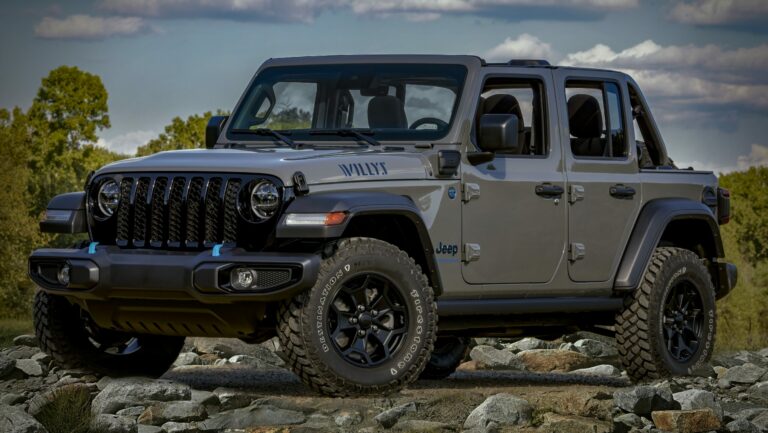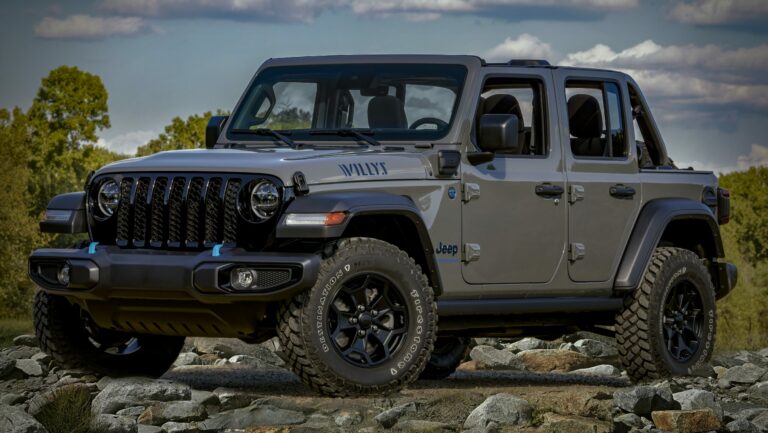Old Jeep Pickup For Sale: Your Ultimate Guide to Finding and Owning a Classic Workhorse
Old Jeep Pickup For Sale: Your Ultimate Guide to Finding and Owning a Classic Workhorse jeeps.truckstrend.com
The phrase "Old Jeep Pickup For Sale" conjures images of rugged individualism, timeless design, and a connection to a bygone era of American utility. More than just a vehicle, an old Jeep pickup represents a piece of automotive history, a blank canvas for customization, a challenging yet rewarding project, or even a shrewd investment. For enthusiasts, collectors, or anyone seeking a unique alternative to modern trucks, the allure of these vintage workhorses is undeniable. They embody a simpler, more mechanical approach to transportation, offering a driving experience that is raw, authentic, and deeply engaging. This comprehensive guide will delve into everything you need to know about finding, evaluating, and owning an old Jeep pickup, transforming your search into an informed and exciting journey.
The Enduring Appeal of Old Jeep Pickups
Old Jeep Pickup For Sale: Your Ultimate Guide to Finding and Owning a Classic Workhorse
What is it about an old Jeep pickup that captures the imagination? It’s a blend of factors: their legendary durability, straightforward mechanical design, and an undeniable aesthetic that speaks to their utilitarian roots. Unlike many classic cars designed for luxury or speed, Jeep pickups were built for purpose – to haul, to work, and to conquer challenging terrain. This inherent ruggedness translates into a vehicle that, despite its age, often remains remarkably capable.
From the post-war Willys-Overland trucks that helped rebuild America to the more refined yet still capable J-series Gladiators and the final Comanche, each model carries a unique legacy. They represent an era when vehicles were less about intricate electronics and more about robust components that could be repaired with basic tools. This simplicity is a major draw for many, offering a sense of control and mechanical understanding often absent in modern vehicles. Furthermore, the strong community of Jeep enthusiasts ensures a wealth of shared knowledge, resources, and camaraderie, making the ownership experience even more fulfilling.
Identifying Your Desired Classic: Key Models and Eras
Before embarking on your search for an "Old Jeep Pickup For Sale," it’s crucial to understand the different models and their unique characteristics. Each era brought distinct designs, capabilities, and levels of rarity.
-
Willys-Overland Pickups (1947-1965): These are the true pioneers. Derived from the CJ-2A civilian Jeep, the Willys pickups feature distinctive flat fenders, a narrow body, and often a rugged, no-frills interior. They were powered by reliable four-cylinder engines (Go-Devil or Hurricane) and later six-cylinders. Finding these in good condition can be challenging, and parts availability may require more diligent searching. They are ideal for those seeking the most authentic vintage Jeep experience.
-
Jeep Forward Control (FC) Series (1956-1965): Arguably the most unique and rarest of the bunch, the FC series featured a distinctive cab-over-engine design, maximizing bed space in a compact footprint. While highly collectible due to their rarity and unusual styling, their specialized design means parts are scarcer, and maintenance can be more complex. They are often sought by niche collectors.
-
Jeep Gladiator / J-Series (1962-1988): This is perhaps the most common and accessible "old Jeep pickup" for sale. Built on the durable SJ platform shared with the Wagoneer and Cherokee Chief, the J-series (initially called Gladiator, later J10, J20, etc.) offered a range of configurations, including short-bed, long-bed, and even crew cab versions. They came with various AMC inline-six and V8 engines, offering more power and creature comforts than their predecessors. Their classic styling, robust drivelines, and relatively better parts availability make them excellent choices for restoration or a reliable classic driver.
-
Jeep Comanche (MJ) (1986-1992): The last traditional Jeep pickup before the brand went without a truck for nearly three decades. Based on the unibody XJ Cherokee platform, the Comanche offered a more modern driving experience with independent front suspension (on 2WD models) and a coil-sprung live axle at the rear. Available with the venerable 4.0L inline-six engine, the Comanche blends classic Jeep ruggedness with improved drivability and better fuel economy than older models. It’s a popular choice for those wanting a classic look with more contemporary performance.

Where to Find Your Old Jeep Pickup For Sale
The hunt for an old Jeep pickup can be an adventure in itself. Here are the most effective avenues to explore:
- Online Marketplaces: Websites like eBay Motors, Craigslist, Facebook Marketplace, and dedicated classic car sites (e.g., Hemmings, ClassicCars.com) are primary sources. For higher-end or rare examples, consider auction sites like Bring a Trailer or Mecum Auctions. Be wary of scams and always verify listings.
- Specialized Classic Car Dealers/Brokers: Many dealers specialize in vintage trucks and SUVs. While prices might be higher, these vehicles are often pre-inspected, and dealers may offer warranties or financing.
- Auctions: Major automotive auctions (Barrett-Jackson, Mecum) often feature well-restored or rare Jeep pickups. Local classic car auctions can also yield good finds. Attend in person if possible to inspect the vehicle.
- Word of Mouth / Local Classifieds: Don’t underestimate the power of community. Join local classic car clubs, attend car shows, and ask around. Many great deals are found through personal connections. Local classifieds in small towns can also uncover hidden gems.
- Swap Meets / Car Shows: These events are excellent for seeing vehicles in person, networking, and sometimes finding parts or even a truck for sale directly from an owner.
What to Look For: Essential Inspection Points
When you find an "Old Jeep Pickup For Sale" that piques your interest, a thorough inspection is paramount. Don’t rush this stage.
- Rust: This is the ultimate enemy. Check the frame rails (especially near spring hangers and body mounts), floor pans, rocker panels, cab corners, bed floor, inner fenders, and door bottoms. Surface rust is manageable; extensive structural rust is a deal-breaker unless you’re planning a full frame-off restoration.
- Engine & Drivetrain: Look for leaks (oil, coolant, transmission fluid). Listen for unusual noises (knocks, rattles, grinding). Check fluid levels and condition. Test the transmission (automatic or manual) for smooth shifts. Engage 4WD (if applicable) in both high and low range. Ask about recent maintenance.
- Suspension & Steering: Check for worn bushings, loose tie rods, leaky shocks, and excessive play in the steering wheel. A test drive will reveal clunks, squeaks, or wandering.
- Brakes: Ensure the pedal is firm, and the truck stops straight without pulling. Check for fluid leaks around calipers or wheel cylinders.
- Electrical System: Test all lights (headlights, tail lights, turn signals, brake lights), wipers, horn, heater/AC, and gauges. Old wiring can be a major headache.
- Interior: Assess the condition of the seats, dashboard, headliner, and door panels. Missing trim pieces can be hard to find.
- Documentation: A clear title is non-negotiable. Look for service records, original owner’s manuals, and any history of major repairs or modifications.
- Originality vs. Modifications: Decide if you want a historically accurate restoration candidate or a modified "restomod" or off-road build. Be aware that extensive modifications can sometimes hide underlying issues.
- Pre-Purchase Inspection (PPI): If you’re serious, especially for a higher-priced vehicle, invest in a PPI by a trusted mechanic familiar with classic vehicles. This small investment can save you thousands.
Understanding Condition and Pricing
The price of an "Old Jeep Pickup For Sale" varies wildly based on its model, rarity, and, most importantly, its condition.
- Project Vehicle ($2,000 – $8,000+): These are often non-running, heavily rusted, or incomplete. They require extensive mechanical and body work, suitable only for those with significant skills, time, and budget for restoration.
- Driver Quality ($8,000 – $25,000+): These vehicles are running and driving, but may have cosmetic imperfections, minor mechanical issues, or require ongoing maintenance. They can be enjoyed immediately while you address improvements over time.
- Restored / Show Quality ($25,000 – $60,000+): These are vehicles that have undergone professional, comprehensive restorations or are exceptionally well-preserved original examples. They command premium prices and are often ready for car shows or reliable classic cruising.
Factors like engine type (e.g., a V8 in a J-series often commands more than an I6), specific trim level, geographic location, and current market demand also influence pricing. Be realistic about your budget for not just the purchase, but also for immediate repairs, registration, insurance, and potential future restoration costs.
The Ownership Experience: Challenges and Rewards
Owning an old Jeep pickup is a unique journey, filled with both challenges and immense rewards.
Challenges:
- Parts Availability: While general mechanical parts for popular models (like the J-series or Comanche) are relatively easy to find, specific trim pieces, body panels, or unique components for rarer models can be elusive and expensive.
- Specialized Mechanics: Not all modern mechanics are comfortable working on carbureted engines, manual transmissions, or older electrical systems. Finding a knowledgeable specialist is crucial.
- Fuel Economy: Older engines, especially V8s, are not known for their fuel efficiency.
- Safety Features: These trucks lack modern safety features like airbags, ABS, or crumple zones. Drive defensively.
- Unexpected Repairs: Like any old vehicle, something will always need attention. Budget for ongoing maintenance and unforeseen issues.
Rewards:
- Unique Driving Experience: The raw, connected feel of driving an old pickup is unlike anything modern.
- Community: The Jeep community is passionate and supportive, offering a wealth of knowledge, parts sources, and friendships.
- Pride of Ownership: There’s immense satisfaction in owning and maintaining a piece of history.
- Potential Appreciation: Well-maintained or restored examples can appreciate in value over time.
- Versatile Utility: These trucks were built to work, and they still excel at hauling, off-roading, or simply making a statement.
Tips for a Successful Purchase
- Define Your Goals: Are you looking for a daily driver, a weekend cruiser, an off-road beast, or a full restoration project? Your goals will dictate the model and condition you should target.
- Set a Realistic Budget: Include not just the purchase price, but also transportation, immediate repairs, registration, insurance, and a contingency fund for unexpected issues.
- Do Your Homework: Research specific model years, common issues, and typical values. Join online forums and Facebook groups dedicated to old Jeep pickups.
- Inspect Thoroughly (and get a PPI): Never buy sight unseen if possible. If you can’t inspect it yourself, hire a professional.
- Don’t Rush: The right truck will come along. Patience is key to avoiding buyer’s remorse.
- Negotiate Respectfully: Be prepared to walk away if the price isn’t right or the seller is unwilling to negotiate fairly.
- Factor in Transportation: Unless you’re buying locally, budget for shipping costs.
- Understand the Title and Registration Process: Ensure the seller has a clear title and that you understand your state’s requirements for registering an older vehicle.
Old Jeep Pickup Estimated Price Guide
Please note: Prices are highly variable based on specific condition, originality, modifications, engine, transmission, and market demand. This table provides estimated ranges for general guidance.
| Model / Series | Era | Condition: Project (Needs Major Work) | Condition: Driver (Functional, Some Flaws) | Condition: Restored / Show Quality |
|---|---|---|---|---|
| Willys Pickups | 1947-1965 | $2,000 – $7,000 | $8,000 – $25,000 | $30,000 – $60,000+ |
| Jeep FC Series | 1956-1965 | $3,000 – $10,000 | $12,000 – $35,000 | $40,000 – $80,000+ (Rarer, Higher Value) |
| Jeep Gladiator / J-Series (J10/J20) | 1962-1988 | $3,000 – $10,000 | $10,000 – $30,000 | $35,000 – $70,000+ |
| Jeep Comanche (MJ) | 1986-1992 | $2,500 – $8,000 | $9,000 – $25,000 | $28,000 – $55,000+ |
Frequently Asked Questions (FAQ) about Old Jeep Pickups For Sale
Q1: Are parts readily available for old Jeep pickups?
A1: It depends on the model. For J-series Gladiators and Comanches, many mechanical parts (engine, transmission, axles) are shared with other popular Jeep models (Wagoneer, Cherokee XJ) and are relatively easy to find new or used. Body panels and specific trim pieces for older Willys or FC models can be much harder to source and more expensive, often requiring reproduction parts or diligent searching at swap meets.
Q2: How much does it cost to restore an old Jeep pickup?
A2: A full, professional restoration can easily cost anywhere from $20,000 to $60,000+, often exceeding the vehicle’s market value unless it’s a rare or highly sought-after model. DIY restorations can be significantly cheaper but require considerable time, skill, and tools. Be realistic about your budget and expectations.
Q3: Can I daily drive an old Jeep pickup?
A3: While possible, it’s generally not recommended for most people due to factors like lower fuel economy, lack of modern safety features, and the potential for unexpected breakdowns. A well-maintained Comanche (MJ) is probably the most suitable for regular driving among the older models. Older models are better suited for weekend cruising, special events, or light utility work.
Q4: What’s the best model for a beginner looking to get into classic Jeeps?
A4: The Jeep J-series Gladiator/truck (J10, J20) or the Jeep Comanche (MJ) are often recommended for beginners. They offer a good balance of classic appeal, better parts availability, and a more straightforward ownership experience compared to the much older Willys or rarer FC models. The Comanche, in particular, offers a more modern driving feel.
Q5: How do I get insurance for a classic vehicle?
A5: Standard auto insurance companies may cover older vehicles, but often with limitations. For true classic or antique vehicles, consider specialized classic car insurance providers (e.g., Hagerty, Grundy). These companies often offer agreed-value policies, lower premiums (due to limited mileage), and tailored coverage that better protects your investment. They typically require the vehicle to be garaged and not used as a primary daily driver.
Conclusion
The journey of finding and owning an "Old Jeep Pickup For Sale" is far more than a simple transaction; it’s an embarkation on a unique automotive adventure. From the venerable Willys to the modern classic Comanche, each model offers a distinct character and a tangible connection to a rich history of utility and rugged capability. While the path to ownership may present challenges in terms of finding the right vehicle, assessing its condition, and maintaining its vintage charm, the rewards are equally substantial. The pride of ownership, the camaraderie of the Jeep community, and the sheer joy of driving a piece of rolling history make the pursuit of an old Jeep pickup an incredibly fulfilling endeavor. With thorough research, a keen eye for detail, and a realistic understanding of the commitment involved, you can transform the dream of owning a classic Jeep pickup into a truly satisfying reality.




